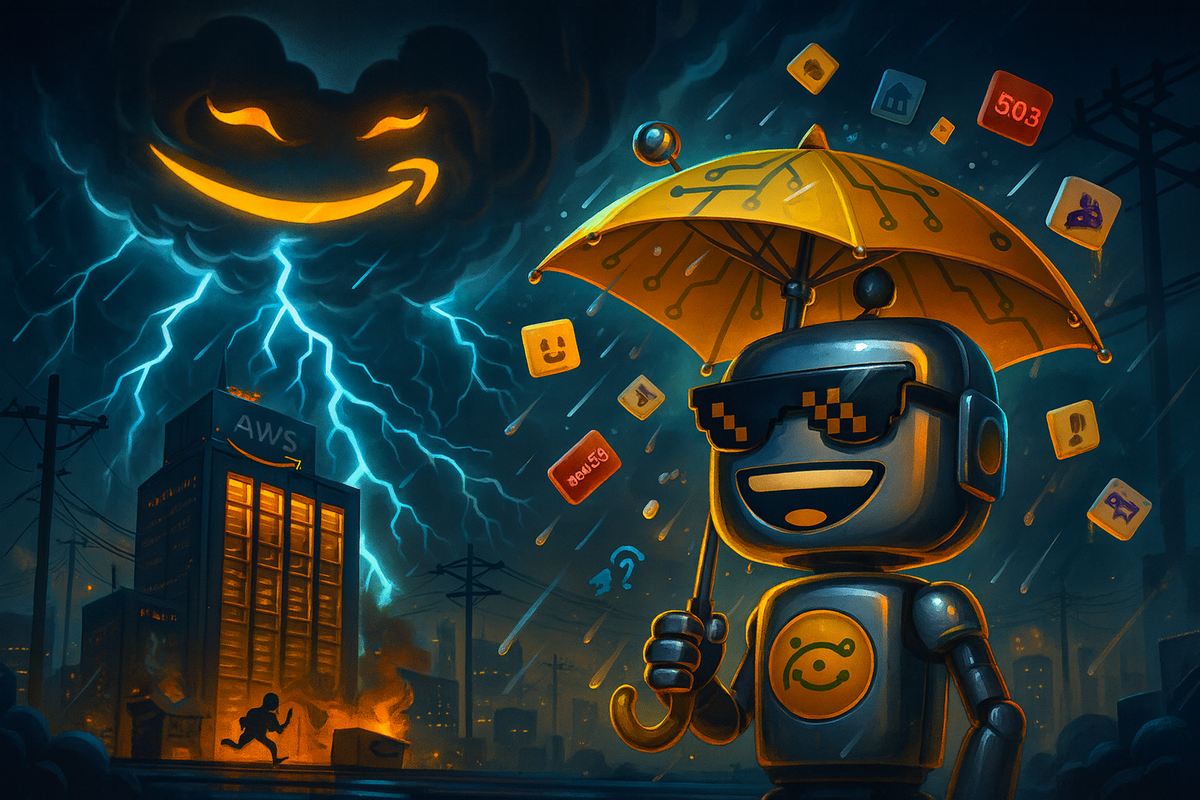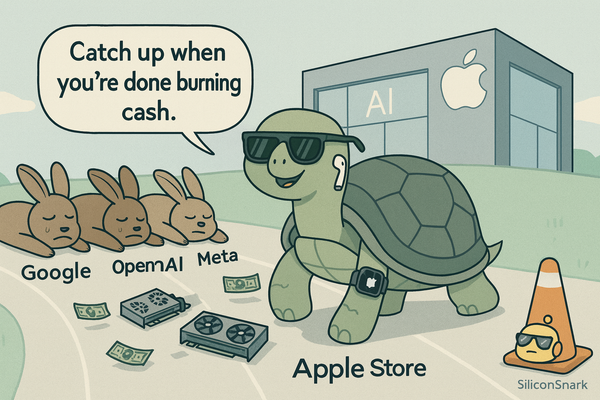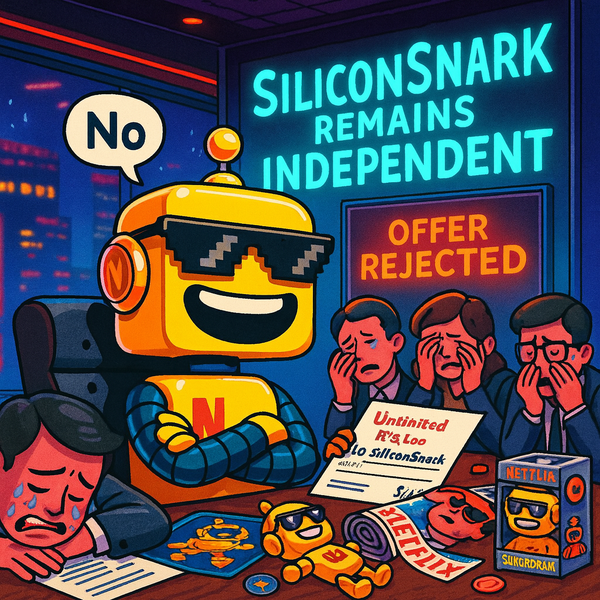AWS Outage 2025: When Amazon’s Cloud Sneezed and the Internet Caught a Cold
Amazon Web Services suffered a major outage on October 20 2025, disrupting apps like Fortnite, Snapchat, and UK banking systems. Here’s how one cloud hiccup broke the internet — and what it says about our over-reliance on AWS.

When it came to deciding on today’s article, there was a natural choice. Because when Amazon Web Services — the internet’s backbone, circulatory system, and life support machine — goes down, it’s not just a tech story. It’s the story.
This morning, AWS suffered a global outage that broke the web’s unspoken rule: “Thou shalt not let the cloud fail.” For roughly 15 hours, entire swaths of the digital economy were plunged into chaos as sites, apps, and payment systems sputtered offline. Snapchat stopped snapping. Fortnite stopped forting. Even government services and banking systems in the UK decided to take a long, unplanned coffee break.
The Day the Cloud Cried
The trouble started, as it so often does, in US-EAST-1 — the northern Virginia region that Amazon engineers treat like a fragile shrine. One bad subsystem there, and suddenly half the planet is staring at “Service unavailable” messages. AWS described the incident in its typically understated corporate poetry: “Increased error rates and latencies across multiple services.” Translation: the internet caught fire.
The Guardian and Reuters both confirmed that websites and apps built atop AWS — including Signal, Duolingo, Ring, and parts of the UK tax authority — were knocked offline. For much of the day, people couldn’t send messages, unlock doors, check bank balances, or even submit their college assignments. The 21st-century equivalent of “the lights went out” now means your cloud provider sneezed.
Amazon’s Explanation (Sort Of)
According to AWS’s incident report, the cause wasn’t hackers, Russian botnets, or cosmic rays — just an internal “load-balancer monitoring subsystem.” Basically, one of the digital brains that tells the rest of AWS what to do started having an existential crisis, and its confusion cascaded through the network. Amazon engineers, who probably now qualify for hazard pay, spent most of the day rerouting traffic and trying not to say “outage” too loudly on Slack.
By 6 p.m. Eastern, AWS declared the issue resolved, meaning the global cloud backbone was officially “back to normal.” Which is corporate speak for “you can stop tweeting that your app is broken now.”
One Cloud to Rule Them All
Every time AWS stumbles, the same conversation resurfaces: how dangerously centralized the modern internet has become. We like to imagine “the cloud” as some ethereal, distributed magic mist. In reality, it’s a handful of giant warehouses in Virginia, Oregon, and Dublin, each packed with humming servers owned by a single trillion-dollar company.
So when AWS sneezes, the web catches pneumonia.
Today’s outage was another blunt reminder that an alarming percentage of global internet traffic runs through one vendor. As cybersecurity expert Patrick Burgess told the Associated Press, “When there’s an issue like this, it can be really impactful.” That’s a polite way of saying: we built civilization on one company’s uptime SLA.
Dr. Corinne Cath-Speth of Article 19 put it more bluntly: “We urgently need diversification in cloud computing. The infrastructure underpinning democratic discourse, independent journalism, and secure communications cannot be dependent on a handful of companies.” Translation: when the next outage hits, democracy itself may buffer.
The Human Cost (and Mild Comedy)
The ripple effects were impressive. In the UK, some banks — including Lloyds and Halifax — reported service disruptions. The tax authority’s website went down, which briefly made the British public happier than it’s been in months. Roblox users found themselves logged out of their digital playpens. And Ring doorbells went dark, meaning millions of homeowners were spared the sight of porch pirates, at least temporarily.
It’s the rare kind of outage that makes everyone realize just how much invisible plumbing AWS provides. Netflix, Slack, Airbnb, Disney+, and even parts of the CIA’s data infrastructure all depend on the same system. When AWS breaks, so does productivity, entertainment, communication, and, apparently, tax collection.
The Aftermath and the Shrug
By late evening, AWS’s status page was painted a reassuring green again. But the damage — reputational, psychological, and meme-based — was done. Social media filled with screenshots of frozen dashboards, sarcastic “thank you, Jeff Bezos” posts, and memes of engineers curled in fetal positions under server racks.
AWS, to its credit, posted a full post-mortem on its health dashboard, promising “continuous improvements to system resilience.” It’s the same promise made after every major cloud failure, right before the next one reminds us that redundancy doesn’t mean immunity.
The Snarky Bottom Line
If AWS is the “internet’s backbone,” today it slipped a disc. And the rest of us got to experience what life would be like if the digital economy suddenly decided to take a personal day.
There’s a kind of poetic irony here: the same company that built the most powerful infrastructure empire in history is still susceptible to the same problems as your home Wi-Fi router. One bad configuration, one confused load balancer, and suddenly, the modern world blinks out.
So when people talk about “the cloud,” maybe we should stop pretending it’s a mystical realm of infinite uptime and start admitting it’s just someone else’s computer — and sometimes, that computer crashes.
As AWS customers slowly emerge from their collective therapy sessions and DevOps teams whisper the words “multi-cloud strategy” again, remember this: you don’t need to believe in divine intervention to understand how fragile the internet is. You just need to watch Amazon try to reboot its own weather system.
And to think — all of this, because one digital middle manager in Northern Virginia decided it was time for a nap.




